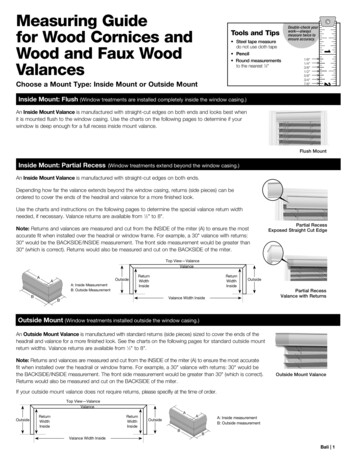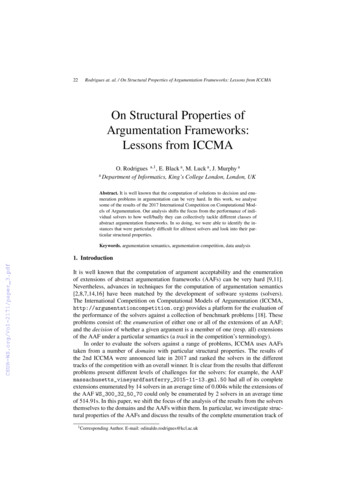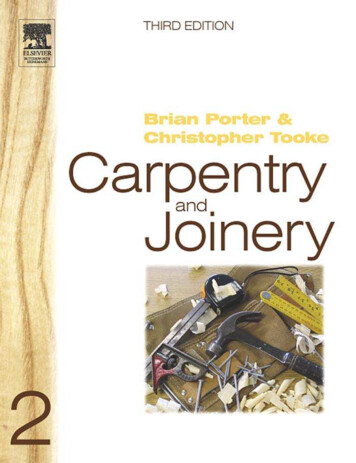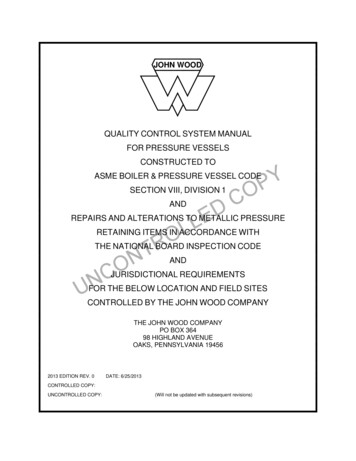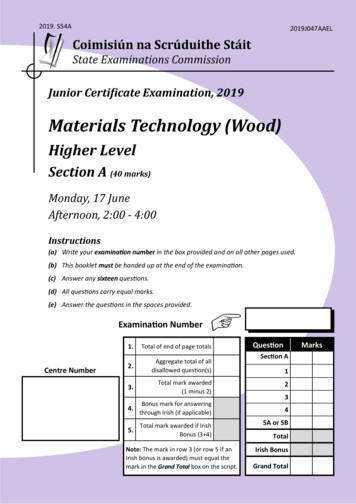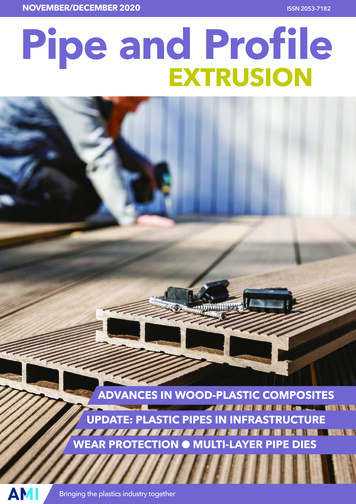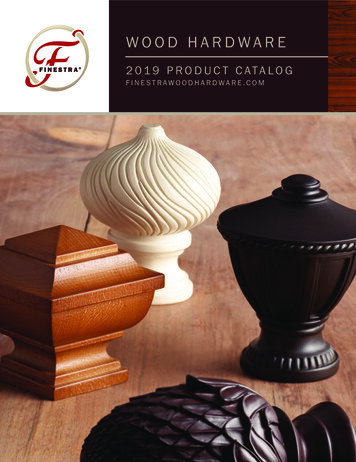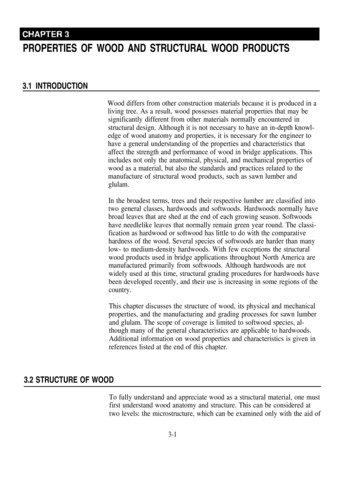
Transcription
PROPERTIES OF WOOD AND STRUCTURAL WOOD PRODUCTS3.1 INTRODUCTIONWood differs from other construction materials because it is produced in aliving tree. As a result, wood possesses material properties that may besignificantly different from other materials normally encountered instructural design. Although it is not necessary to have an in-depth knowl edge of wood anatomy and properties, it is necessary for the engineer tohave a general understanding of the properties and characteristics thataffect the strength and performance of wood in bridge applications. Thisincludes not only the anatomical, physical, and mechanical properties ofwood as a material, but also the standards and practices related to themanufacture of structural wood products, such as sawn lumber andglulam.In the broadest terms, trees and their respective lumber are classified intotwo general classes, hardwoods and softwoods. Hardwoods normally havebroad leaves that are shed at the end of each growing season. Softwoodshave needlelike leaves that normally remain green year round. The classi fication as hardwood or softwood has little to do with the comparativehardness of the wood. Several species of softwoods are harder than manylow- to medium-density hardwoods. With few exceptions the structuralwood products used in bridge applications throughout North America aremanufactured primarily from softwoods. Although hardwoods are notwidely used at this time, structural grading procedures for hardwoods havebeen developed recently, and their use is increasing in some regions of thecountry.This chapter discusses the structure of wood, its physical and mechanicalproperties, and the manufacturing and grading processes for sawn lumberand glulam. The scope of coverage is limited to softwood species, al though many of the general characteristics are applicable to hardwoods.Additional information on wood properties and characteristics is given inreferences listed at the end of this chapter.3.2 STRUCTURE OF WOODTo fully understand and appreciate wood as a structural material, one mustfirst understand wood anatomy and structure. This can be considered attwo levels: the microstructure, which can be examined only with the aid of3-1
a microscope, and the macrostructure, which is normally visible to theunaided eye.MICROSTRUCTUREThe primary structural building block of wood is the wood cell, or tra cheid. When closely packed, these wood cells form a strong compositesystem that is often compared to a bundle of drinking straws (Figure 3-1).As a unit, the straws (wood cells) weigh very little, but if restrained fromlateral buckling, they will support a substantial load in compressionparallel to their longitudinal axis. If the straws are loaded in compressionperpendicular to their longitudinal axis, they will yield under relativelylight loads. Using this analogy, it is easy to visualize the superior strengthto-weight ratio of a cellular composite such as wood. Yet, each individualwood cell is even more structurally advanced because it is actually amultilayered, filament-reinforced, closed-end tube rather than just ahomogeneous, nonreinforced straw (Figure 3-2).MACROSTRUCTUREThe cross section of a tree can be divided into three basic parts: bark,cambium, and wood (Figure 3-3). Bark is the exterior layer and is com posed of an outer layer of corky material with a thin inner layer of livingFigure 3-1.- Simplified depiction of the structure of wood, comparing it to a bundle ofthin-walled drinking straws. (A) Parallel to their longitudinal axis, the straws (wood cells)can support loads substantially greater than their weight. (B) When loaded perpendicular totheir longitudinal axis, the straws yield under much lower loads.3-2
Figure 3-2.- Drawing of the magnified structure of a softwood.cells. It functions to protect the tree and to conduct nutrients. The cam bium is a thin, continuous ring of reproductive tissue located between thewood and the bark. It is the only portion of the tree where new wood andbark cells are formed and is usually only one to ten cells thick, dependingon the season of the year. All material inside the cambium layer is wood,which conducts and stores nutrients and provides the tree with structuralsupport. At the center of the wood, where tree growth began, is the pith orheart center.Wood is divided into two general classes, sapwood and heartwood. Thesapwood consists of both active and inactive cells and is located on theoutside of the tree, next to the cambium. It functions primarily in foodstorage and the transport of sap. The radial thickness of sapwood is com monly 1-1/2 to 2 inches for most species, but it may be 3 to 6 inches thickfor some species. Heartwood, which was once sapwood, is composedmostly of inactive cells that differ both chemically and physically fromsapwood cells. The heartwood cells do not function in either food storageor sap transportation. In most species, the heartwood contains extractive3-3
Figure 3-3.- Tree cross section showing elements of the macrostructure that are normallyvisible without magnification.substances that are deposited in the cell during the conversion from sap wood to heartwood. These deposits frequently give the heartwood a muchdarker color than sapwood; however, in several species the heartwood isnot dark and looks virtually the same as sapwood. The extractives alsoserve to make the heartwood of several species more resistant to attack bydecay fungi and insects. Because all heartwood was once sapwood, thereis generally little difference in their dry weight or strength.Growth in wood cells varies between cells that are formed early in thegrowing season, earlywood cells, and those formed late in the growingseason, latewood cells. Earlywood cells are usually formed during the firstor second month of the growing season and have relatively large cellcavities and thin walls. Latewood cells are formed later in the growingseason and have smaller cell cavities and thicker walls. The contrastbetween the earlywood and latewood cells forms the characteristic growthrings common to most species (Figure 3-4). These growth rings vary inwidth, depending on species and site conditions. In many species ofsoftwood, such as Douglas-fir and Southern Pine, there is a marked con trast between the earlywood and latewood, and growth rings are plainlyvisible. In other species, such as spruces and true firs, the change fromearlywood to latewood is less obvious, and rings are more difficult to see.Environmental conditions can also affect growth rings. Rings formed3-4
Figure 3-4.- Cross section of a pine log showing growth rings. Light bands are earlywood,dark bands are latewood. A growth ring is composed of the earlywood ring and thelatewood ring outside it.during short or dry seasons are narrower than those formed under morefavorable growing conditions.3.3 PHYSICAL PROPERTIES OF WOODPhysical properties describe the quantitative characteristics of wood andits behavior to external influences other than applied forces. Included aresuch properties as moisture content, density, dimensional stability, thermaland pyrolytic (fire) properties, natural durability, and chemical resistance.Familiarity with physical properties is important because those propertiescan significantly influence the performance and strength of wood used instructural applications.3-5
DIRECTIONAL PROPERTIES Wood is an orthotropic material with unique and independent properties indifferent directions. Because of the orientation of the wood fibers, and themanner in which a tree increases in diameter as it grows, properties varyalong three mutually perpendicular axes: longitudinal (L), radial (R), andtangential (T). The longitudinal axis is parallel to the grain direction, theradial axis is perpendicular to the grain direction and normal to the growthrings, and the tangential axis is perpendicular to the grain direction andtangent to the growth rings (Figure 3-5). Although wood properties differin each of these three directions, differences between the radial and tan gential directions are normally minor compared to their mutual differenceswith the longitudinal direction. As a result, most wood properties forstructural applications are given only for directions parallel to grain(longitudinal) and perpendicular to grain (radial and tangential).Figure 3-5- The three principal axes of wood with respect to grain direction and growthrings.MOISTURE CONTENTThe moisture content of wood (MC) is defined as the weight of water inwood given as a percentage of ovendry weight:MC moist weight ovendry weightx 100 percentovendry weight(3-1)In living trees, water is required for growth and development, and waterconstitutes a major portion of green wood. Depending on the species andtype of wood, the moisture content of living wood ranges from approxi mately 30 percent to more than 250 percent (two-and-a-half times theweight of the solid wood material). In most species, the moisture contentof the sapwood is higher than that of the heartwood (Table 3-1).3-6
Table 3-1 .-Average moisture content of green wood.Water exists in wood as bound water, which is molecularly bonded withinthe cell walls, and as free water, which is present in the cell cavities(Figure 3-6). When moist wood dries, free water separates first and at arate faster than bound water. The moisture content at which the cell wallsare saturated with water, but at which virtually no free water exists in thecell cavities, is called the fiber saturation point. The fiber saturation pointfor most woods averages about 30 percent, but may vary by a few percent age points among different species.Figure 3-6.- Diagrammatic representation of wood moisture content.3-7
Wood is a hygroscopic material that absorbs moisture in humid environ ments and loses moisture in dry environments. Therefore, the moisturecontent of wood is a result of atmospheric conditions and depends on therelative humidity and temperature of the surrounding air. Under constanttemperature and humidity conditions, an equilibrium moisture content(EMC) is reached. The equilibrium moisture content represents a balancepoint where the wood is neither gaining nor losing moisture and is inequilibrium with the environment. In bridge applications, wood moisturecontent is almost always undergoing some changes as temperature andhumidity conditions vary. These changes are usually gradual, short-termfluctuations that influence only the wood surface. Over a period of time,however, the wood will approach an equilibrium moisture content relatedto the environment. The time required to reach the equilibrium moisturecontent depends on the size and permeability of the member, the tempera ture, and the difference between the initial moisture content of the woodand the eventual equilibrium moisture content for the environment. Therelationship between equilibrium moisture content, relative humidity, andtemperature is generally independent of species and is shown in Table 3-2.Table 3-2.- Moisture content of wood in equilibrium with stated dry-bulb temperature and relativehumidity.DIMENSIONAL STABILITYWood is dimensionally stable when the moisture content is above the fibersaturation point. Below the fiber saturation point, wood shrinks whenmoisture is lost and swells when moisture is gained. This susceptibility todimensional change is one of the few wood properties that exhibit signifi cant differences for the three orthotropic axes. In the longitudinal direc tion, average shrinkage values from green to ovendry conditions arebetween 0.1 and 0.2 percent, which is generally of no practical concern. In3-8
Figure 3-7.- Approximate wood shrinkage relationships below the fiber saturation pointfor the three orthotropic axes (adapted from the Canadian Wood Council 13). Used bypermission.the tangential and radial directions, however, shrinkage is much morepronounced (Figure 3-7).Wood shrinkage is approximately a linear function of moisture content,and dimensional changes below approximately 24 percent can be deter mined with reasonable accuracy. An example of shrinkage calculationsbased on the values given in Figure 3-7 is shown in Example 3-1. Moreaccurate methods for computing shrinkage are given in the Wood Hand 30book. Although formal shrinkage calculations are normally not requiredin structural design, the designer must be aware that wood is not a staticmaterial and that dimensional changes occur.3-9
Example 3-1- Wood shrinkage from a decrease in moisture contentDetermine the approximate changes in depth and width occurring whenthe wood member shown below dries from an initial moisture content of28 percent to an equilibrium moisture content of 18 percent.SolutionThe orientation of the annual rings is approximately parallel with thenarrow face of the member. Therefore, shrinkage in the tangential directionwill affect member width, while shrinkage in the radial direction will affectmember depth.Approximate dimensional changes between two moisture contents areobtained from Figure 3-7. In the radial direction, shrinkage from fibersaturation to 28-percent moisture content is approximately 0.2 percent. AtM-percent moisture content, the change is approximately 1.4 percent. Thepercent shrinkage in the radial direction between 28-percent and 18-percentmoisture content is the difference between the two values:Percent radial shrinkage 1.4% - 0.2% 1.2%Applying the percentage shrinkage to the dimension at 28-percent moisturecontent gives the shrinkage in inches:Radial shrinkage 0.012(15.5 in.) 0.2 in.Shrinkage in the tangential direction is determined in the same manner.From fiber saturation, tangential shrinkage is approximately 0.3 percent at28-percent moisture content and 2.1 percent at 18-percent moisturecontent:Percent tangential shrinkage 2.1% - 0.3% 1.8%Tangential shrinkage 0.018(5.5 in.) 0.1 in.In summary, the member will shrink about 0.2 inch in depth and 0.1 inch inwidth.3-10
The effects of uneven drying plus shrinkage differences in the tangentialand radial direction can cause wood pieces to distort or warp (Figure 3-8).In addition, the uncontrolled drying or seasoning of wood frequentlycauses lengthwise separations of the wood across the annual rings, com monly known as checks (Figure 3-9). Most checks are not of structuralsignificance; however, when checking extends from one surface to theopposite or adjoining surface (through-checks) the strength and otherproperties of the piece may be affected.Figure 3-8.- Characteristic shrinkage and distortion of wood as affected by the direction ofthe growth rings. Such distortion can result in warp, which is generally classified as bow,twist, crook, and cup.DENSITYThe density of a material is defined as the mass per unit volume at somespecified condition. For a hygroscopic material such as wood, densitydepends on two factors, the weight of the basic wood substance and theweight of the moisture retained in the wood. Wood density varies withmoisture content and must be given relative to a specific condition in orderto have practical meaning. Values for density are generally based on thewood weight and volume at one of three moisture conditions: (1) ovendry,where the moisture content is zero; (2) green, where the moisture contentis greater than 30 percent; or (3) in-use, where the moisture content isspecified between ovendry and green.3-11
Figure 3-9.- Checks are lengthwise separations of the wood, perpendicular to the growthrings, caused by uncontrolled shrinkage in the tangential direction.The density of ovendry wood varies within and among species. While thedensity of most species is between 20 and 45 lb/ft 3, the range in densitiesextends from approximately 10 lb/ft3 for balsa to more that 65 lb/ft3 forsome imported woods. Average densities for green wood and wood at4,30different moisture contents are given in several reference publications.3For bridge applications, a density of 50 lb/ft is normally used as an aver age density for all species and moisture contents (Chapter 6).SPECIFIC GRAVITYSpecific gravity provides a relative measure of the amount of wood sub stance contained in a sample of wood. It is a dimensionless ratio of theweight of a volume of wood at a specified moisture content to the weight3of an identical volume of water at 62.4 lb/ft . For example, a volume ofwood with a specific gravity of 0.50 at some moisture content would have33a density of 31.2 lb/ft (0.50 x 62.4 lb/ft ). In most applications, specificgravity is either reported on the basis of ovendry weight and green volumeor ovendry weight and volume at 12 percent moisture content. For engi neering purposes, specific gravity is normally based on the ovendryweight and the volume at 12 percent moisture content.THERMAL EXPANSIONThermal expansion of dry wood is positive in all directions; it expandswhen heated and contracts when cooled. The linear expansion coefficientsof dry wood parallel to grain are generally independent of species andspecific gravity and range from approximately 0.0000017 to 0.0000025per degree Fahrenheit. The expansion coefficients perpendicular to grainare proportional to density and range from five to ten times greater thanparallel to grain coefficients. Wood is a good insulator and does notrespond rapidly to temperature changes in the environment. Therefore, itsthermal expansion and contraction lag substantially behind temperaturechanges in the surrounding air.3-12
Wood that contains moisture reacts to temperature changes in a mannerdifferent from that of dry wood. In most cases, thermal expansion andcontraction are negligible compared to the expansion and contraction frommoisture content changes. When moist wood is heated, it tends to expandbecause of normal thermal expansion and to shrink because of moistureloss from increased temperature. Unless the initial moisture content of thewood is very low (3 to 4 percent), the net dimensional change on heatingis negative. Wood at intermediate moisture contents of approximately 8 to20 percent will expand when first heated, then gradually shrink to asmaller volume as moisture is lost in the heated condition. In most bridgeapplications, the effects of thermal expansion and contraction in wood arenegligible.COEFFICIENTS OFFRICTIONThe coefficients of friction for domestic softwoods vary little amongspecies and depend on wood moisture content and roughness of the sur face. On most materials, friction coefficients for dry wood increase asmoisture increases to the fiber saturation point. Above the fiber saturationpoint, friction coefficients remain fairly constant until considerable freewater is present. When the surface is flooded with water, the coefficientsof friction decrease. The sliding coefficient of friction for wood is nor mally less than the static coefficient and depends on the speed of sliding.Sliding coefficients vary slightly with speed when the moisture content isless than approximately 20 percent. At higher moisture contents, slidingcoefficients decrease substantially as speed increases. Coefficients ofsliding friction for smooth, dry wood against a hard smooth surface aver age from 0.3 to 0.5. At intermediate wood moisture contents, values rangefrom 0.5 to 0.7 and increase to 0.7 to 0.9 as the moisture content nearsfiber saturation. Average coefficients of friction for several conditions aregiven in Table 3-3.Table 3-3.- Average coefficients of friction for wood.ELECTRICALCONDUCTIVITYDry wood is a good electrical insulator and exhibits only minor variationsin conductivity relative to variations in species and density, but significantalterations in conductivity can be related to variations in grain orientation,temperature, and moisture content. The conductivity of wood is approxi3-13
mately twice that for parallel to grain than for perpendicular to grain, andOgenerally doubles for each 18 F increase in temperature. Although electri cal properties generally have little effect on bridge design, the correlationbetween the electrical conductivity and moisture content is the basis forelectrical resistance-type moisture meters that are commonly used inbridge inspection and other activities related to product manufacturing(Chapter 13).PYROLYTIC PROPERTIESThe pyrolytic or fire properties of wood are perhaps the most misunder stood of all wood properties. Because wood burns, it is intuitivelyassumed that the performance of wood under fire conditions must be poor.In fact, the heavy wood members typically used in bridges provide a fireresistance comparable to, or greater than, that of other constructionmaterials.When wood is exposed to fire, the exterior portions of the membermay ignite. If enough energy is focused on the member, sustained, selfpropagating flaming will occur. The wood beneath the flame undergoesthermal decomposition and produces combustible volatiles that sustain theflame. However, as the wood burns, a char layer is formed that helpsinsulate the unburned wood from engrossing flames (Figure 3-10). As thesurface char layer increases, the amount of combustible volatiles releasedfrom the uncharred wood decreases, and the rate of combustion slows. Thedepth of the char layer under constant fire exposure increases at a rate ofapproximately 1- 1/2 inches per hour for Douglas-fir, but varies for otherspecies and fire exposure conditions.Figure 3-10.- Degradation zones in a wood section exposed to fire.3-14
Although wood burns, its low specific gravity and thermal conductivity,combined with the insulating char layer, result in a slow rate of heattransmission into the solid, unburned wood. The surface chars, but theundamaged inner wood below the char remains at a relatively low tem perature, thereby retaining its strength. As a result, the member willsupport loads equivalent to the capacity of the remaining uncharred sec tion. It is this charring that allows wood to retain residual strength withOsurface temperatures of 1,500 F or more. In addition, wood does notappreciably distort under high temperatures as most other materials do.When steel is subjected to elevated surface temperatures, its high massdensity and thermal conductivity transport heat relatively quickly through Oout the member. At temperatures of 1,500 F, the yield strength of steel isless than 20 percent of that at room temperature.26 Thus, under fire expo sure, a steel member reaches its yield temperature and fails rapidly understructural load. A classic example of this scenario is shown in Figure 3-11.Figure 3-11.- Damage resulting from a large building fire. Steel members yielded by theheat are supported by a charred wood beam.NATURAL DURABILITYThe natural durability of wood, or its resistance to decay and insect attack,is related to species and anatomical characteristics. In general, the sap wood of all species has little resistance to deterioration and fails rapidly inadverse environments. When heartwood is considered, natural durability3-15
depends on species. Since the time of the Phoenicians, carpenters haveknown that the heartwood of some species exhibits greater durability inground or marine environments. As discussed earlier, heartwood forms asthe living sapwood cells gradually become inactive. In some species,sugars and other extraneous materials present in the cells are converted tohighly toxic extractives that are deposited in the wood cell wall. In addi tion, some heartwoods contain internal crystalline deposits that inhibitattack by marine borers and insects. There are many species of wood inthe world that provide durable heartwood, but few are found in NorthAmerica. Baldcypress (old growth), cedars, and redwood are three NorthAmerican commercial species that are recognized as naturally durable;however, durability varies within a tree and among species (Table 3-4).Because of this variability, it is unreliable to depend on natural durabilityfor protection in structural applications, although many electric utilitiescontinue to use untreated cedar poles installed in the 1930’s. To ensureuniform performance, wood used in bridge applications is treated withwood preservatives that protect the structure from decay and deteriorationfor many years (Chapter 4).Table 3-4.- Grouping of some domestic species according to approximaterelative heartwood decay resistance.Resistant orvery resistantBaldcypress(old growth)CedarsRedwoodCHEMICAL RESISTANCEModeratelyresistantBaldcypress(young growth)Douglas-firWestern larchEastern white pineLongleaf pineSlash pineTamarackSlightly ornonresistantHemlocksPine (other thanlongleaf, slash,eastern white)SprucesTrue firs (westernand eastern)Wood is resistant to many chemicals. In the chemical processing industry,it is the preferred material for processing and storing chemicals that arevery corrosive to other materials. In isolated cases, the presence of strong.acids or bases can cause wood damage. Strong bases attack the hemicellu lose and lignin, leaving the wood a bleached white color. Strong acidsattack the cellulose and hemicellulose, causing weight and strength losses.Chemical resistance is normally not a concern in bridge applications withthe exception of de-icing chemicals that are used in some parts of thecountry. Because wood is resistant to these chemicals, it has a markedadvantage over more vulnerable materials, such as steel and concrete.3-16
3.4 MECHANICAL PROPERTIESMechanical properties describe the characteristics of a material in re sponse to externally applied forces. They include elastic properties, whichmeasure resistance to deformation and distortion, and strength properties,which measure the ultimate resistance to applied loads. Mechanical prop erties are usually given in terms of stress (force per unit area) and strain(deformation per unit length).The basic mechanical properties of wood are obtained from laboratorytests of small, straight-grained, clear wood samples free of natural growthcharacteristics that reduce strength. Although not representative of thewood typically used for construction, properties of these ideal samples areuseful for two purposes. First, clear wood properties serve as a referencepoint for comparing the relative properties of different species. Second,they may serve as the source for deriving the allowable properties ofvisually graded sawn lumber used for design (Chapter 5).ELASTIC PROPERTIESElastic properties relate a material’s resistance to deformation under anapplied stress to the ability of the material to regain its original dimensionswhen the stress is removed. For an ideally elastic material loaded belowthe proportional (elastic) limit, all deformation is recoverable, and thebody returns to its original shape when the stress is removed. Wood is notideally elastic, in that some deformation from loading is not immediatelyrecovered when the load is removed; however, residual deformations aregenerally recoverable over a period of time. Although wood is technicallyconsidered a viscoelastic material, it is usually assumed to behave as anelastic material for most engineering applications, except for time-relateddeformations (creep), discussed later in this chapter and in Chapter 5.For an isotropic material with equal properties in all directions, elasticproperties are described by three elastic constants: modulus of elasticity(E), shear modulus (G), and Poisson’s ratio (µ). Because wood isorthotropic, 12 constants are required to describe elastic behavior: 3moduli of elasticity, 3 moduli of rigidity, and 6 Poisson’s ratios. Theseelastic constants vary within and among species and with moisture contentand specific gravity. The only constant that has been extensively derivedfrom test data, or is required in most bridge applications, is the modulus ofelasticity in the longitudinal direction. Other constants may be availablefrom limited test data but are most frequently developed from materialrelationships or by regression equations that predict behavior as a functionof density. General descriptions of wood elastic properties are given belowwith relative values for a limited number of species in Table 3-5. Foradditional information, refer to the references listed at the end of the10,30chapter.3-17
Table 3.5. - Elastic ratios for selected species.Modulus of ElasticityModulus of elasticity relates the stress applied along one axis to the strainoccurring on the same axis. The three moduli of elasticity for wood aredenoted EL, ER, and ET to reflect the elastic moduli in the longitudinal,radial, and tangential directions, respectively. For example, EL, which istypically denoted without the subscript L, relates the stress in the longitu dinal direction to the strain in the longitudinal direction.Shear ModulusShear modulus relates shear stress to shear strain. The three shear modulifor wood are denoted GLR, GLT and GRT for the longitudinal-radial, longitudinal-tangential, and radial-tangential planes, respectively. For example,GLR is the shear modulus based on the shear strain in the LR plane and theshear stress in the LT and RT planes.Poisson’s RatioPoisson’s ratio relates the strain parallel to an applied stress to the accom panying strain occurring laterally. For wood, the six Poisson’s ratios aredenoted µLR, µLT, µRT, µTL, and µTL. The first letter of the subscript refersto the direction of applied stress, the second letter the direction of theaccompanying lateral strain. For example, µLR is Poisson’s ratio for stressalong the longitudinal axis and strain along the radial axis.STRENGTH PROPERTIESStrength properties describe the ultimate resistance of a material to appliedloads. They include material behavior related to compression, tension,shear, bending, torsion, and shock resistance. As with other wood proper ties, strength properties vary in the three primary directions, but differ ences between the tangential and radial directions are relatively minor and3-18
are randomized when a tree i
structural design. Although it is not necessary to have an in-depth knowl edge of wood anatomy and properties, it is necessary for the engineer to have a general understanding of the properties and characteristics that affect the strength and performa
